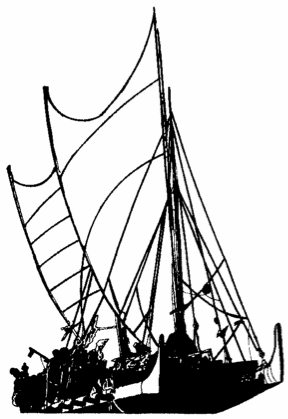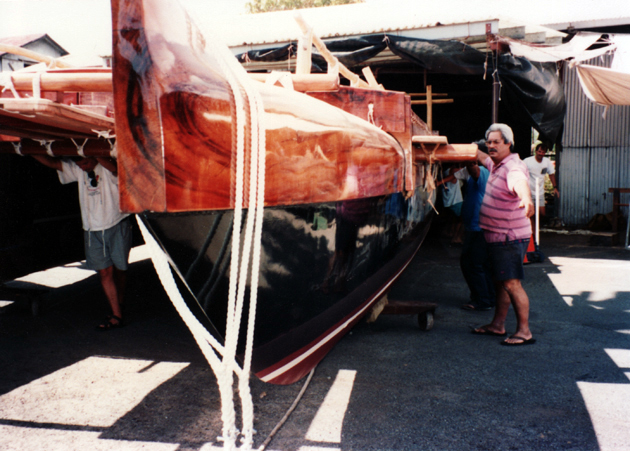PVS Newsletter / Fall 1993
The Blessing and Launching of Hawai'i Loa
Master Canoe Builder Wright Bowman, Jr, who oversaw the building of Hawai‘iloa, led her out of the halau.
On the morning of July 24, 1993 at Pier 36, two and a half years of work on the voyaging canoe Hawaii Loa came to fruition. After the sounding of the pu, Parley Kanaka'ole offered a kahea chant and Master of ceremony Wayne
Chang introduced the blessing and launching program.
The sky was heavily overcast, and gust of rain swept down from the Ko'olau mountains all morning long. Rainbows arched above the green hills and grey city. One was reminded of the blessing of the magical canoe of Rata, the Tahitian voyaging hero, many centuries ago:
"At daybreak the artisans invoked the presence of Ta'aroa of the river in darkness, presenting him with some sennit as a peace offering, and his acceptance was soon made manifest by his sending them a heavy shower of rain to immerse the ship, which was their way of performing the ceremony of fa'ainu (making it drink).... Then with the little elves clinging to the ship, the mountain breeze caught it and wafted it high up on the shining clouds, which bore elves and ship far beyond the land and out over the open sea, where they descended by the rainbow... and set the canoe as lightly as a bird upon the waters" (Teuira Henry,Ancient Tahiti, 489).
Kahu 'Ai Kapu Bert Barber conducted the 'ai kapu ritua -the offering up of sacred foods to the Hawaiian canoe deities, foremost of which is Kci. Barber was assisted by his ha'i'olelo (spokesman) Keone Nunes.
The foods prepared by Barber were kumu, ulu, and hiwa coconuts, traditionally used in ceremonies. Ka-huna Pule (master of prayer) Kalena Silva accepted these sacred foods and offered them to the Kahuna Kdlai Wa'a (master canoe builder) Wright Bowman, Jr., and his workers, all of whom were seated in the kapu area.
Kahuna Pule Silva then blessed Hawai'i Loa and lifted the kapu which had been placed on the canoe. Finally, the canoe was lowered into the water and floated there, as light as a bird.
Haku Mele (composer) Keli'i Tau'a, assisted by Charles Kaupu, recited a genealogical chant he had composed for Hawal‘i Loa, telling of the unsuccessful search for logs in the koa forests of Hawai‘i and the gifting of nvo spruce logs by the Haida and Tlingit people of Alaska; the naming
of the logs Kutx ah yunahha kah ya tun ("Star is the constellation steering by the star"); the naming of the canoe after Hawai'i Loa, who discovered Hawai'i; the carrying on of the voyaging tradition by Nainoa Thompson and his navigators and crews; the building of the canoe by Wright Bowman, Jr., and his workers.

Keli‘i Tau‘a blessing Hawai‘iloa
As the mele inoa was recited, the canoe was rigged and a lauhala sail hoisted. Lei of maile and 'ie'ie were used for adornment. Then the canoebuilders boarded the canoe and dipped their paddles into the water for the symbolic first voyage of Hawaii Loa. They chanted "la Wa'a
Nul," which was used at the launching of Hokule‘a at Kualoa, O'ahu, in 1975:
Ia wa'a nui (That large canoe)
Ia wa'a kioloa (That long canoe)
Ia wa'a peleleu (That broad canoe)
A lele mamala (Let chips fly)
A manu o uka (Bird of the upland)
A manu o kai (Bird of the lowland)
'I'iwi polena (Yellow honcycreeper)
A kau ka hoku (The stars appear)
A kau i ka malama (The daylight arrives)
A pae i kula (Land on shore)
'Amama ua noa (Amama, the kapu is free).
As the chant ended, Tau'a asked the canoe's owner, the Native Hawaiian Culture and Arts Program, represented by chairman Clayton Hee, if he found the canoe maika'i (good). He answered "maika'i!" and the ceremony ended with the sounding of the pu.
Our family from Alaska, represented by Judson Brown and Byron Mallot, were honored next and acknowledged for their generous donation of the spruce logs for Hawaii Lods hulls. The day ended with speeches and ho'okupu to Hawaii Loa. Kahu Kalili offered a Christian blessing. Food and
entertainment provided closure to this special day.
Hawai'i Loa has been built to recover Hawaiian canoe-building traditions and to recreate early settlement voyages to Hawai'i from the Marquesas islands, over 1600 years ago. Scholars believe such voyages took place, because of similarities between the languages, artifacts, culture, and physical characteristics of the peoples of the two island groups. In 1995, the Polynesian Voyaging Society plans to sail Hawaii Loa from Nuku Hiva in the Marquesas to Hawai'i, a 2,200-mile voyage.
The hulls of Hawaii Loa were designed by Dick Rhodes and Rudy and Barry Choy. Wright Bowman, Jr., Wally Froiseth, and Nainoa Thompson designed the other parts of the canoe. The construction of the 57-foot voyaging canoe by Kahuna Mai Wa'a Wright Bowman, Jr., under funding by the Native Hawaiian Culture and Arts Program, began in 1991. The kuamo'o, or hulls, of Hawai‘iloa have been carved from Alaskan spruce logs; koa has been used for the manu, or curved bow and stern pieces, as well as for the mo'o, or side pieces above the gunwales. The 'iako, or cross pieces, and kia, or masts, are made from ‘ohia logs. The railings are made from hau. Some
sennit has been used in the lashings. Lily Jane Nunies and Elizabeth Akana wove the lau hala sail. Mary Lou Kekuewa made the lei hulu (feather lei).
On the morning of July 31, 1993 Hawai'i Loa proudly sailed into Poka‘i Bay. The canoe was welcomed warmly and generously by the people of Nandkuli and Wai'anae. Hawaii Loa was accompanied by Hokule; E'ala; Mauloa; and Maikai Roa. The event, entitled “Eia Hoi Na Holowa'a” (Behold the Voyaging Canoes)" was a celebration of the Hawaiian seafaring and canoe building heritage.
Once again, the volunteers of PVS, came through, this time led by Moku Froiseth and Paige Barber. They organized and carried out both the blessing and launching of Hawaii Loa and “Eia Hoi Na Holowa'a.” Randle Fong coordinated the programs for both events. Maholo to Paige, Moku, Randie of Kamehameha Schools and all the volunteers.
1992 Voyage, No Na Mamo, “For the Children”: 1. Voyage to Tahiti
Tommy Holds – As We Knew Him
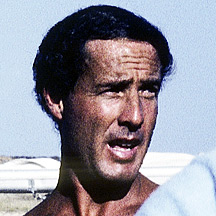
by Keali‘ipu‘aimoku & Wallace Froiseth
[On August 23, 1993, Tommy Holmes, one of the founders of the Polynesian Voyaging Society, died of a heart attack while paddling an outrigger canoe off Waikiki. One of his lasting legacies is The Hawaiian Canoe, the most comprehensive modern study of the subject, published in 1981 and reprinted in a second edition in September, 1993. On August 28, his ashes were carried out to sea by the Hokule‘a and scattered off Waikiki. Hundreds attended the ceremony.]
Tommy Holmes was like another hanai son to Wally and me. We both had the deepest respect and admiration for him and supported his many interests and human causes. He was very respectful of everyone. One of Tommy's main interests was the Polynesian Voyaging Society and Hokule‘a. He was the driving force to raise funds to make the first voyage possible.
Tommy was an exceptional waterman; he was adept at everything to do with the ocean and ocean sports. We first knew him when he was very young through the sport of surfing and canoeing, at which he was very skillful. He was always looking for new challenges and ways to appreciate nature. When he participated in anything he did it with all his heart and soul, all the way and whatever it took. He helped with the challenging food preparations for Hokule‘aa’s first voyage. His careful arrangements to obtain the proper plants and animals, such as Maxwell, the pua‘a (pig), Hoku, the Hawaiian ‘ilio (dog), and the proper moa (chicken) showed us what an interested and dedicated person he was. In Tahiti after the first trip Tommy assisted us in planting at Tahiti's Gauguin Museum grounds all the plants he had cared for on the trip. Tommy was a person always wanting to do the best job he could, as shown in his definitive work The Hawaiian Canoe. We're sure that Tommy had a sense of fulfillment, happiness and peace in creating all of these interests for all of us to enjoy.
Over dinner Tommy and Moku discussed their high cholesterol counts, which he accepted philosophically, almost like it was no big thing and he would not slow down. He continued to do the things he wanted to do in his life. Through all of this we both vowed to take better care of our conditions. For Tommy we feel we must accept his death as the loss of a creative individual. His mind was precious, but mortal. Aloha Tommy, we love you and deeply appreciate having known you. We’ll all miss you.
We also mourn the passing of Parley Kanaka'ole. Heartfelt sympathy to all his family and friends. He played important roles in the ceremonies for the blessing and launching of Mauloa and Hawai'i Loa and the celebration of voyaging, at Poka‘i Bay. His presence will be missed; his mana remains with us.
The 45-foot E'ala ('Awaken!') was built in 1979 at Poka‘i Bay to revive the art of canoe building on the Wai'anae Coast. It was refurbished by the Polynesian Voyaging Society in 1993 for use in crew training and educational programs.
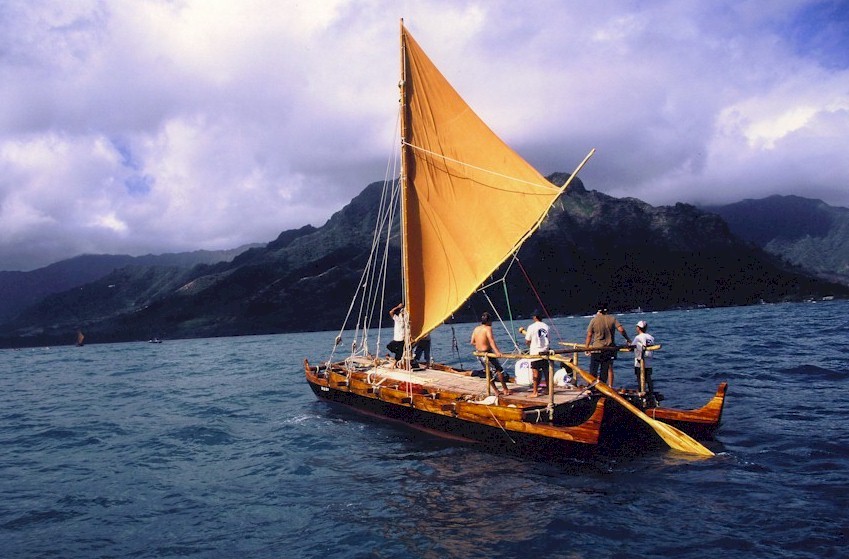
Photo from the Wai‘anae Hawaiian Civic Club website
The 27-foot Mauloa was built at Honaunau under canoe builder and navigator Mau Piailug from Satawal, Micronesia. The hull was carved from a koa log donated hy the Bishop Estate. Workers used stone, then steel adzes. The project was coordinated by Clay Bertelmann.
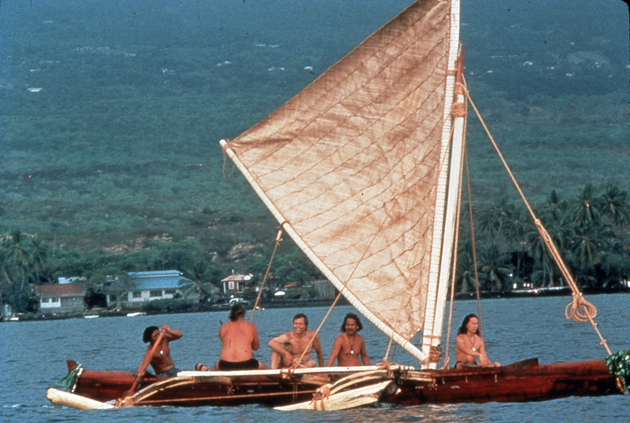
The PVS Vision
Ho‘olokahi: to bring about unity and harmony among humanity, nature, and spiritual forces
Mission & Goals
The mission of the Polynesian Voyaging Society (PVS) is to contribute toward a safe and healthy future for Hawai'i. Its goals are:
- To sponsor or conduct research and educational projects in order to identify values and recover practices and arts, such as canoe construction and navigation, that allowed for the successful exploration and settlement of Pacific islands.
- To inform the public through various media about Polynesian voyaging and to disseminate research data that might be useful to scientists and others engaged in maritime endeavors.
- 0 To develop curriculum and educational programs that encourage the people of Hawai'i to explore their environment and heritage and make discoveries about how best to contribute to the well-being and survival of the community.
- 0 To work with other organizations to explore and design ways of fulfilling human needs through technology while maintaining a balance between people and the environment
Guiding Values
Aloha ‘Aina: to understand the interdependence of humanity and the environment
‘Imi ‘Ike: to seek knowledge
Lokomaik‘'i: to share with each other
Malama: to care for each other
Na‘au Pono: to possess a deep sense of justice which fosters positive relationships among people
PVS Officers and Board of Directors
Officers: Myron "Pinky" Thompson, President; Kapua Lindo, Vice President; Virginia Elliott, Treasurer
Directors: Gilbert Ane, Moku Froiseth, Wally Froiseth, Harry Ho, Rey Jonsson, Eric Martinson, Jerry Muller, Laura Thompson, Michael Tongg, Nathan Wong, Bob Worthington, August Yee
Consultant: Ben Finney
